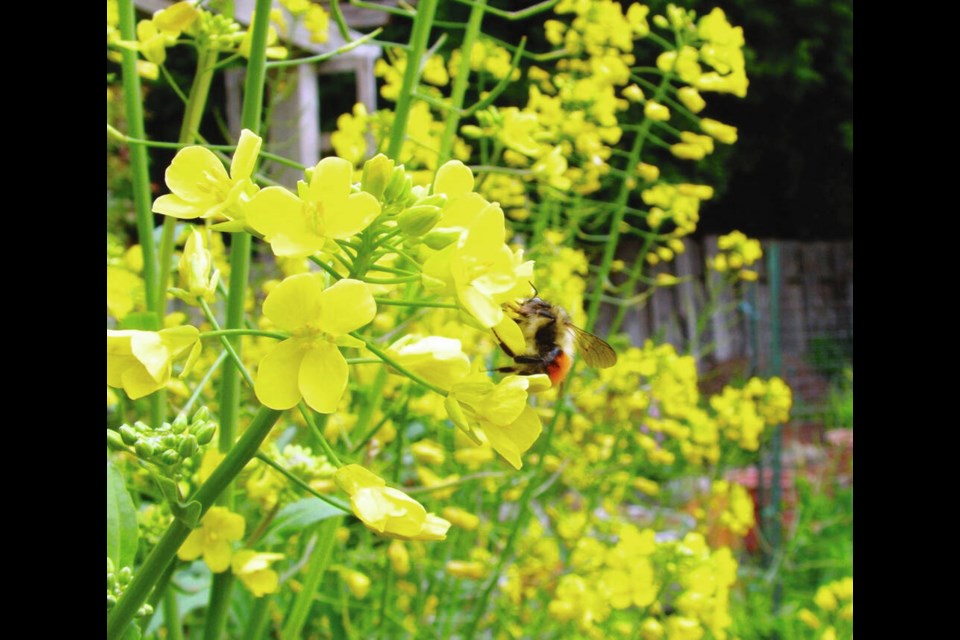Dear Helen: My kale plants survived the heavy snow and freezing temperatures, and I look forward to harvesting their nutritious greens again through early spring. My problem is the space they take as they expand into flowering mode, just when I need to make new, spring vegetable plantings.
L.V.
Leaving kale to bloom, at least for a while, brings benefits to a garden and the environment. The flowers are an important food source for bees and other pollinators and also for the beneficial insects that help to control pests in our gardens. Allowing the plants time to bloom can also almost guarantee a few seeds will develop and be dispersed to germinate the following spring to produce extra-strong and productive plants.
Most gardens these days have space issues. Planting kale along a plot edge makes it as simple as possible to fit spring plantings in the plot.
Dear Helen: Early in the fall I removed weedy, invasive plants from a small plot adjacent to my town house. The bare soil soon became a litter box for neighbourhood felines. Is there anything I could plant that would repel cats or prevent them from digging in the plot?
R.M.
Various plants are reputed to be effective cat repellents, but no scientific studies that I know of have proven their efficacy in that role.
Cats are said to avoid strong citrus scents, as in lemon balm, lemon thyme and lemon-scented geraniums. I notice in the Richters herb catalogue a listing for Plectranthus ‘Sumcol 01’ — a distinct variety created from crossing two species of Plectranthus.
The resulting variety has a particularly pungent fragrance. The plants are rounded and compact, 25-cm tall and 30 cm wide, with fleshy, light green leaves. Common names for cat-repelling Plectrantus varieties are “scaredy cat plant” and “piss-off plant.”
An alternative cat-deterrent measure would be to plant a ground cover or covers that would form a tight mat of growth over the ground, preventing the cats from digging. Some of the thymes are excellent for this, and some are lemon scented. One of my favourite lemon thymes is Doone Valley, a mat-forming creeper with small, dark green, gold tipped leaves and purple-pink summer flowers. Doone Valley plants are not usually hard to find early in the spring wherever herb plants are sold.
Minus thyme is another ground-hugging, tight-knit ground cover that I’m glad to have in the garden. These are happily minimum-care plants as long as they have plenty of sun and a well-drained soil.
A tour through the thymes at richters.com will offer you further choices to ponder.
While ground covers are expanding to fill spaces between transplants, it may be necessary to lay light wire fencing, such as poultry netting, over the bed — at least long enough to break the cats’ habit of frequenting the spot.
Dear Helen: When can I start pruning my Hybrid Tea rose bushes? They are messy. Injuries from a serious accident late in the summer prevented me from keeping the young shrubs dead-headed and tidied.
B.A.
I hope you will have recuperated enough to fully enjoy spring in your garden. As for the rose bushes, wait until late winter to prune, in weather that is dry and above freezing.
I watch for growth buds along the canes to begin swelling. This usually happens during the latter part of February. The swelling signifies that sap has begun to flow actively in the plant and pruning cuts will heal quickly.
The slight enlargement of the buds also makes them easy to see for placing precise pruning cuts.
Begin the pruning by removing, dead, broken and clearly diseased growth. Make the cuts at the cane’s point of origin or above a healthy-looking growth bud pointing outward from the bush. Then remove weak, spindly growth and any headed into the centre of the plant. Thin to reduce crowding, always cutting away the weakest growth in congested areas.
Aim to end up with four or five of the strongest, youngest, healthiest canes. Shorten them by removing between a third to a half of the cane’s length. Remove the least on the strongest, thickest canes, following the old pruning adage: Let the strongest grow the longest.
Make these cuts a scant six mm above and parallel to a bud that points outward, away from the centre of the bush.



